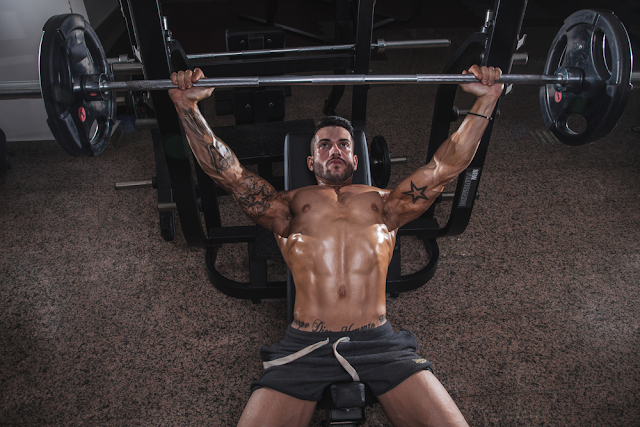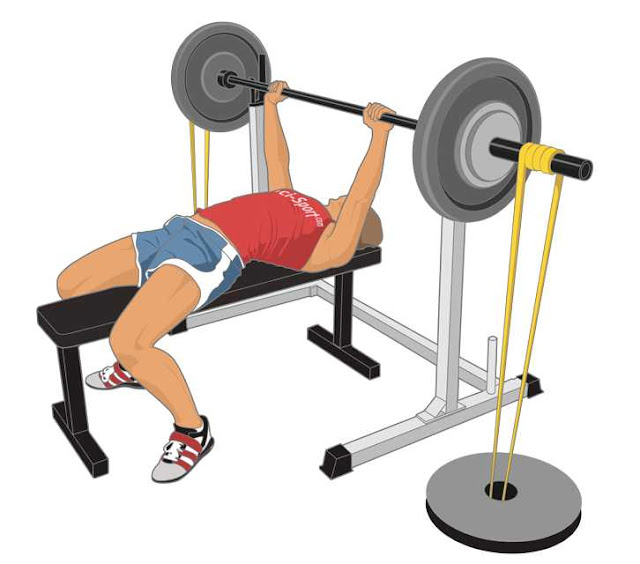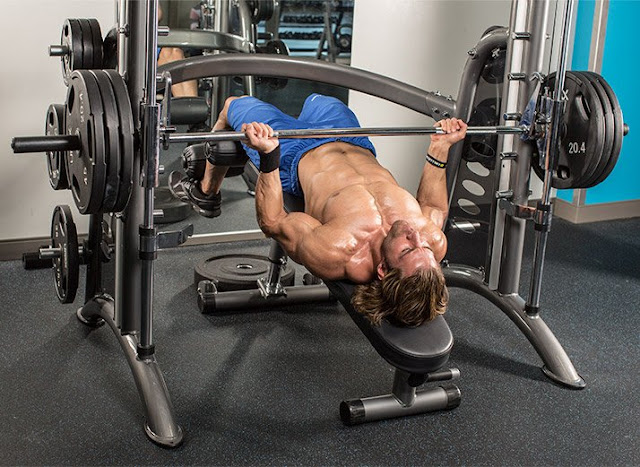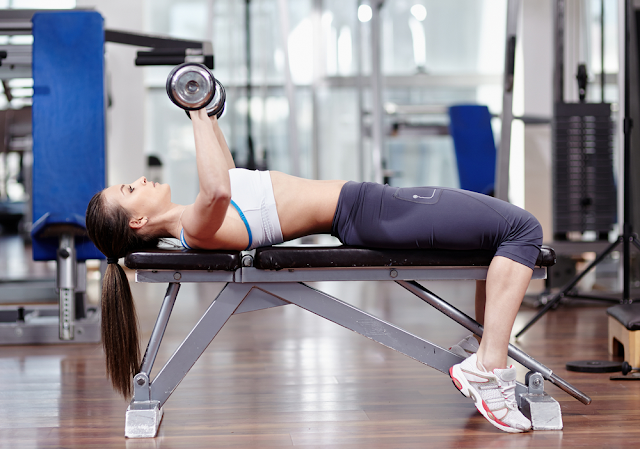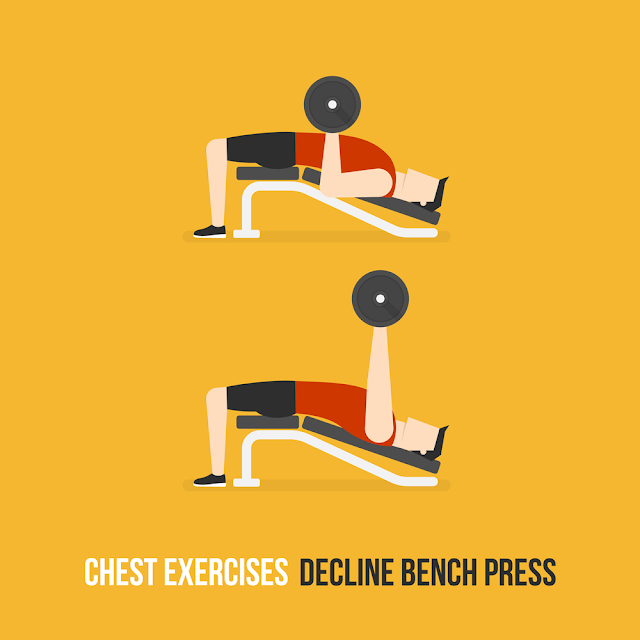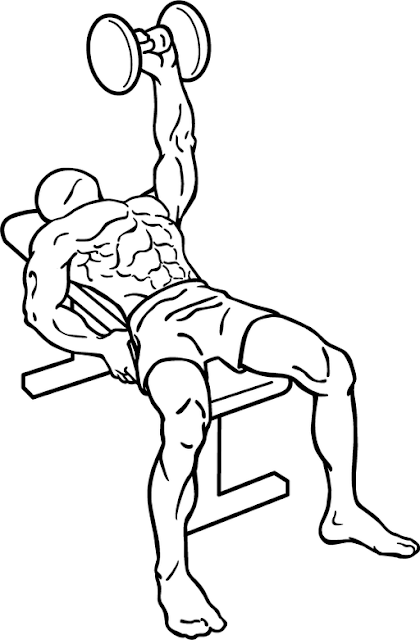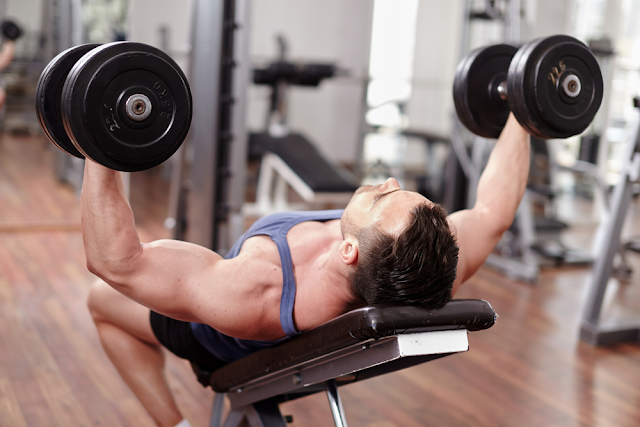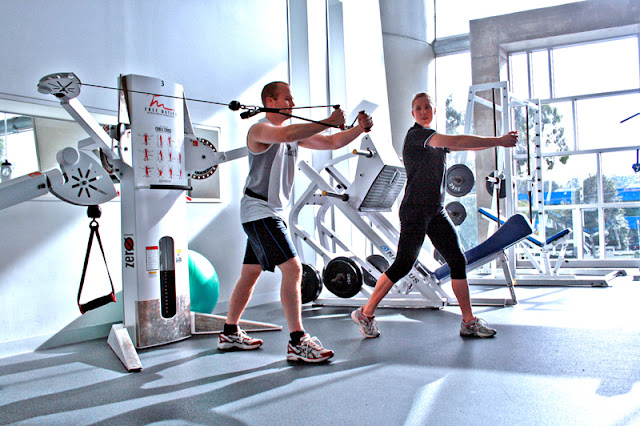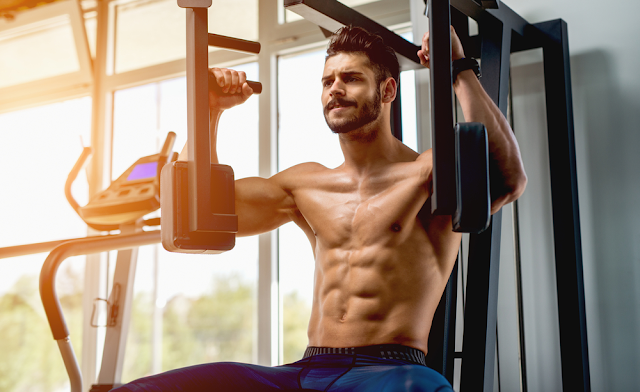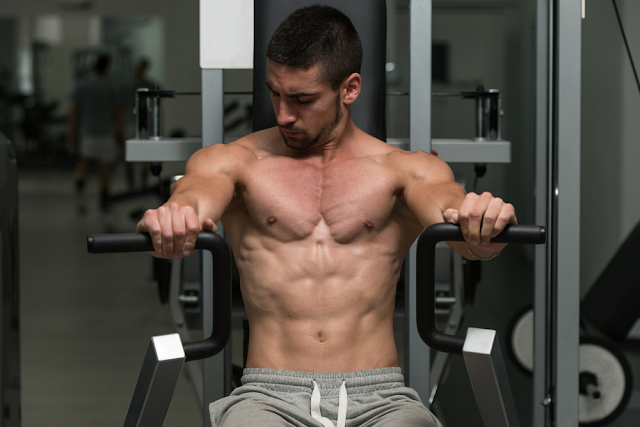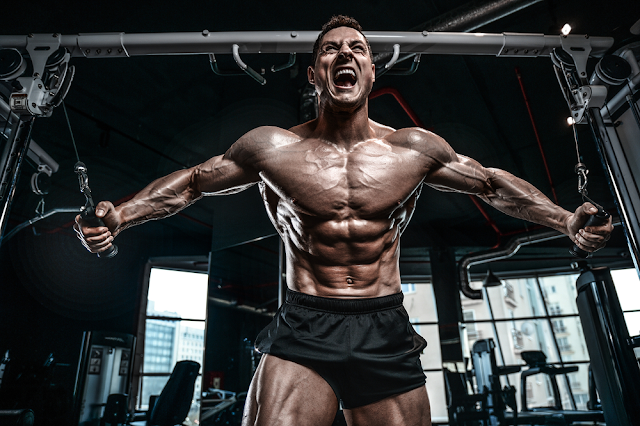Build Massive Chest with Chest Exercise Database
If you really want a chest like Arnold or best chest in your gym then you need targeted chest exercises that hit each and every muscle of your chest.
As you know Chest is the biggest front upper body muscle and if you want to build giant 56-inch chest then you need proper nutrition along with those chest exercises which can hit your pecs from every angle.
Today, in this article I bring all the 37-chest exercises that you can find in the fitness industry. These 37-chest exercises not only build your chest but also build your front shoulder and triceps up to certain extent.
37 best Chest exercises list going to soo long so make sure you take your pre-workout or snacks.
There are many types of exercise so I will break down the list according to Equipment you have or you need to, you can find exercises as per your need.
- Barbell pressing exercises (13)
- Dumbbell Pressing Exercises (7)
- Fly-type Exercises (11)
- Machine, cable or Band pressing Exercise (6)
The most chest exercises have two movements either pressing the weight or flying movement so we are going to see 13 pressing movement chest exercises using the barbell.
13 Barbell pressing Chest exercises
1). Bench Press: if you don’t know this exercise is listed as ‘GOLDEN 5 exercise because if you doing this exercise you can develop your chest but not from every angle. There are many variations of doing bench press that can hit every chest muscle.
Trained Muscle: Pectoralis major, Long tricep Head, Front shoulder
Equipment: Barbell and Bench
Difficulty: Beginner
How-To Do it Proper?
Start Position: Lie Faceup on a bench-press bench with your feet flat on the floor. Grasp the barbell with an overhand grip, hands slightly wider than shoulder-width apart. Make sure to make a proper arch between your lower-back and bench.
If you are beginner then you don't need to do this but, in the future, this will help you to lift more weight.
Moving Position: Unrack the bar and slowly lower it toward your sternum. keep your wrist aligned with your elbows and your elbow should point out to your side so upper arms make a 30 to 60-degree angle with your torso.
when the bar touches your chest, press back up explosively and that it. It is your First repetition of bench press.
2). Incline Bench Press: Like I said, there are many variations of bench-pressing to hit every chest muscles. This exercise will hit your Pectoralis major muscle. In this variation of chest press your front shoulder work more than the long head of triceps.
Trained Muscle: Pectoralis major, Long tricep Head, Front shoulder
Equipment: Barbell and Bench
Difficulty: Beginner, Intermediate
How-To Do it Proper?
Start Position: Lie on an incline bench-press bench and grasp the racked barbell with a slightly wider grip than shoulder width. palms should face toward the ceiling.
Lift the bar off the rack and raise it until your arms are fully extended
Moving Position: Bend your elbows to lower the bar to your upper chest. At the bottom, your elbows should be out and away from your body but slightly in front of your shoulders.
Contract your chest muscles and extend your elbows to press the bar up until your elbows are almost locked out.
3). Decline Bench Press: this is another good version of chest press to hit your pectoralis minor. This exercise focuses more on your lower-pecs than bench-press.
Trained Muscle: Pectoralis minor
Equipment: Barbell and Bench
Difficulty: Beginner, Intermediate
How-To Do it Proper?
Starting position: Lie back on a decline bench-press and set a 30 to 40-degree decline angle. Grasp the barbell with an overhand grip with both hands slightly wider than shoulder-width apart.
Lift the bar off the supports and hold it over your lower chest with your arms extended.
Moving Position: Lower the barbell to your lower chest slowly and immediately push the bar back up to full extension without locking your elbows out at the top.
4). Barbell bench press with BANDS: this is almost similar to the conventional barbell bench press. Using resistance bands is very useful to put some extra resistance. You can use the different type of resistance band that you have or in the gym.
Trained Muscle: Pectoralis major, Long tricep Head
Equipment: Barbell, Bench and Resistance band
Difficulty: Advanced
How-To Do it Proper?
Starting Position: Place an exercise band securely under the bench and secure each barbell cuff onto either side of the barbell. An easy way to secure the ends of the bands on the bar is by placing them between two weight plates.
If you cannot place the band under the bench, then use one band on each end of the bar and secure it to a heavy dumbbell on each side under the bar.
Moving Position: Perform the bench press as you normally would as describe earlier. You can also use the bands in a similar manner on the incline bench press and decline bench press.
5). Barbell Floor Press: This is also similar but there is a big difference and that can increase your strength. If you haven’t tried this exercise then you should give it a try. Because it is hard to lift a barbell from your chest level.
Trained Muscle: Pectoralis major, Long tricep Head, Front shoulder
Equipment: Barbell
Difficulty: Intermediate, Advanced
How-To Do it Proper?
Starting Position: Although this is a bench press done on the floor, unless you are very thin, you will not be able to fit under the bar even when it is loaded with 45-pound plates.
So, you will need to set the bar on the lower rack of a power rack, lie faceup on the floor in the middle of your power rack. so that the bar is above your head. Unrack the barbell and hold it over your chest.
Moving Position: Lower the bar toward your lower chest until the back of your upper arms touch the floor. The bar will be several inches above your chest and will not touch your chest.
This is the point of doing the floor press because it lessens the range of motion, which allows you to use more weight. press the bar up and toward your head so that bar is above your upper chest in the top position.
6). Reverse-grip bench press: You might think that what is the use of this exercise or it is hard to perform. But You know where is disadvantages there are also advantages. This exercise is best for hit your lower pecs.
Trained Muscle: Pectoralis minor
Equipment: Barbell and Bench
Difficulty: Intermediate and Advanced
How-To Do it Proper?
Starting Position: Grasp the barbell with an underhand grip with your hands spaced wider than shoulder-width apart.
Moving Position: Have a spotter help you unrack the bar because it is difficult to do so alone with the underhand grip. Once the bar is positioned over your chest, lower the bar to your chest or upper abs and then press the bar back up toward your head.
If you must do this exercise alone, unrack the bar with an overhand grip and lower it to your chest. with the bar on your chest, carefully swap your grip from overhand to underhand and perform the exercise.
7). Smith Machine Bench-Press: there is no difference between bench-pressing and smith machine bench-press. If you are complete beginner then I suggest that you should start with this machine. This will help you to increase your strength so you can do flat bench-press without any kind of support.
Trained Muscle: Pectoralis major, Long triceps Head, Front shoulder
Equipment: Smith Machine
Difficulty: Beginner
How-To Do it Proper?
Starting Position: Position yourself on a flat bench that is positioned in a Smith machine so that the bar lines up with your lower chest.
Grasp the bar with an overhand grip spaced slightly wider than shoulder-width apart. Release the safety hooks.
Moving Position: Lower the bar to your chest. Press the bar back up to full arm extension, stopping just short of elbow lockout. Pause at the top and lower the bar under control to your chest.
8). Smith machine Incline Bench-press: IF you are a week at doing incline bench press then you can start from this machine.
Trained Muscle: Pectoralis major, Long tricep Head, Front shoulder
Equipment: Smith Machine
Difficulty: Beginner
How-To Do it Proper?
Starting position: Position yourself on an incline bench and set it to about 30 to 40-degrees. That is positioned in a smith machine so that the bar lines up with the top of your chest.
Grasp the bar with an overhand grip spaced slightly under than shoulder-width apart and release the safety hooks.
Moving position: Lower the bar to your chest. Press the bar up to full arm extension, stopping just short of elbow lockout.
9). Smith machine Decline Bench-press: Doing chest exercises on the smith machine to lift more or correct your form. So if you found difficulty in doing conventional decline bench press then you can do it on a smith machine.
Trained Muscle: Pectoralis minor
Equipment: Smith Machine
Difficulty: Beginner
How-To Do it Proper?
Starting machine: Position yourself on a decline bench and angle of the bench should be 30 to 45-degrees that is positioned in a smith machine so that the bar lines up with the lower part of your chest.
Grasp the bar with an overhand grip that is slightly wider than shoulder-width apart. Release the safety hooks.
Moving Position: Lower the bar to your chest. Press the bar up to full arm extension, stopping just short of elbow lockout.
10). One-arm Smith machine bench press: This is a great exercise if you want to focus on particular one muscle or on a week muscle. You can also fix your chest muscle imbalance through this exercise.
Trained Muscle: Pectoralis major, Long tricep Head, Front shoulder
Equipment: Smith Machine
Difficulty: Intermediate and Advanced
How-To Do it Proper?
Starting Position: Position yourself on a flat bench that is positioned in a smith machine so that the bar lines up with your lower chest.
Grasp the bar with a one-hand grip that is spaced slightly wider than shoulder-width apart.
Moving position: Release the safety hooks and then slowly lower the bar to your chest. Press the bar back up to full arm extension. Stopping just short of elbow lockout.
Complete all reps on one arm and then repeat with the other arm.
11). One-arm Smith Machine Negative Bench press: this exercise is similar to the above exercise but there is a difference like the difference between bench-pressing and floor bench-press. In this exercise, you have to lift a weight from your chest, not from the rack.
Trained Muscle: Pectoralis major, Long tricep Head, Front shoulder
Equipment: Smith Machine
Difficulty: Intermediate and Advanced
How-To Do it Proper?
Starting Position: If you train alone then it is impossible for you to do negative reps. Yet Smith machine allows you to train with negative reps one arm at a time.
Position yourself on a flat bench that is in a smith machine so that the bar lines up with your lower chest.
Grasp the bar with a one-hand overhand grip that is spaced slightly wider than shoulder-width apart.
Moving Position: Release the safety hooks and then slowly lower the bar about a quarter of the way down. From there, resist the bar as long as you can to prevent the bar from lowering to your chest.
It should take you no less than 3 seconds and no more than 8 seconds for the weight to reach your chest.
If it is shorter than this, decrease the weight and if it longer than this, increase the weight.
12). Smith Machine bench press throw:
Trained Muscle: Pectoralis major, Long tricep Head, Front shoulder
Equipment: Smith Machine
Difficulty: Advanced
How-To Do it Proper?
Starting Position: Position yourself on a flat bench that is in a smith machine so that the bar lines up with your lower chest.
Grasp the bar with an overhand grip that is spaced slightly wider than shoulder-width apart. Release the safety hooks.
Moving Position: Slowly lower the bar to your chest and explode the bar off of your chest by press the bar back up to full arm extension with as much speed and power as possible.
Catch the bar on the return with slightly bent elbows without stopping the bar and guide it down to your chest and then immediately perform the next rep.
13). Smith Machine Reverse Grip Bench Press:
Trained Muscle: Pectoralis minor
Equipment: Smith Machine
Difficulty: Beginner, Intermediate
How-To Do it Proper?
Starting Position: Position yourself on a flat bench that is in a Smith machine so that the bar lines up with your lower chest or upper abs. Grasp the bar with an underhand grip that is spaced slightly wider than shoulder-width apart. Release the safety hooks.
Moving position: Slowly lower the bar to your chest and then press the bar back up to full arm extension, stopping just short of elbow lockout. You can also do this on an incline bench.
Now it’s time to see 7 Dumbbell Chest Pressing Exercises. A benefit of doing an exercise using dumbbell is you can increase your Range of motion. You can stretch more of your muscle.
7 Dumbbell Pressing Chest Exercises
1). Dumbbell Bench Press: For this exercise, you only need a bench and a pair of dumbbells. There is two difference in dumbbell and barbell chest exercise that is greater ROM and you can lift more using dumbells. Make sure if you are beginner then it is hard to make a balance so make sure if beginner doing this exercise then start it using lightweight.
Trained Muscle: Pectoralis major, Long tricep Head, Front shoulder
Equipment: Dumbbell and Bench
Difficulty: Beginner
How-To Do it Proper?
Starting Position: Lie faceup on a flat with your feet planted flat on the floor. Hold the dumbbells just outside your chest with your elbows out to your sides.
So, your upper arms form a 30-to-60-degree angle with your torso.
Moving Position: Forcefully press the weights up in an arc until your arms are fully extended above your chest. Reverse the motion, being sure not to lower the dumbbells below chest level.
2). Incline dumbbell press: If you want to increase your range of motion then you can use dumbbells because there is a restriction when you incline bench press.
Trained Muscle: Pectoralis major, Long tricep Head, Front shoulder
Equipment: Dumbbell and Bench
Difficulty: Beginner
How-To Do it Proper?
Starting Position: Lie squarely on an incline bench, which should be set at a fairly low angle, less than 45 degrees. Hold the dumbbells just outside your shoulders with your elbows out to your sides and your feet planted flat on the floor.
Moving Position: Forcefully press the weights up in an arc until your arms are fully extended above your chest. Reverse the motion, being sure not to lower the dumbbells below chest level.
3). Decline Dumbbell Press: This exercise is better than barbell decline press because it emphasizes more on your lower chest.
Trained Muscle: Pectoralis minor
Equipment: Dumbbell and Bench
Difficulty: Beginner
How-To Do it Proper?
Starting Position: Lie back on a decline bench set to 30 to 40 degrees with your feet secured under the foot pads. Holds the dumbbells just outside your lower chest with your elbows out to your sides.
Moving Position: Forcefully press the weights up in an arc until your arms are fully extended above your lower chest our upper abs.
4). One-Arm Dumbbell Bench Press:
Trained Muscle: Pectoralis major
Equipment: Barbell and Bench
Difficulty: Beginner, Intermediate
How-To Do it Proper?
Starting Position: Grasp a dumbbell and lie faceup on the bench. Hold the dumbbell just outside your shoulder with your elbows out to your sides. With your other arm, grasp the side of the bench down by your hip.
Moving Position: Press the dumbbell up until your arm is fully extended above your chest. Reverse the motion, being sure not to lower the dumbbells below lower chest level. Complete the desired number of reps and repeat with your other arm.
5). Exercise ball Dumbbell Press: an advantage of doing this exercise is you can learn to balance your body and how to tight your core during reps.
Trained Muscle: Pectoralis major, Long tricep Head, Front shoulder
Equipment: Exercise Ball
Difficulty: Intermediate and advanced
How-To Do it Proper?
Starting Position: Grasping two dumbbells, lie with your upper back on an exercise ball with your feet planted firmly on the floor. Hold the dumbbells just outside your shoulders with your palms facing forward and your elbows out to your sides.
Moving Position: Forcefully press the weights up in an arc until your arms are fully extended above your chest. Reverse the motion, being sure not to lower the dumbbells below your chest level.
6). Neutral-Grip flat Bench Press: I believe that this exercise is better than conventional dumbbells bench press because it gives more activation of your chest muscles.
Trained Muscle: Pectoralis major
Equipment: Barbell and Bench
Difficulty: Intermediate
How-To Do it Proper?
Starting Position: Grasping two dumbbells, lie on a flat bench and turn your wrists so that they are toward each other, hands at each side of your torso with the dumbbells above your body.
Moving Position: Press the dumbbells upward, allowing them to naturally move toward each other at the top (without touching). Then reverse the move back to the starting position.
7). Reverse grip Dumbbell Press:
Trained Muscle: Pectoralis minor
Equipment: Barbell and Bench
Difficulty: Beginner, Intermediate
How-To Do it Proper?
Starting Position: Lie on a flat bench while holding one dumbbell in each hand outside your chest. Turn your wrists outward so that your palms are pointed toward your face for the position known as the reverse grip.
Moving Position: Press the dumbbells up and together in an arc over your chest while maintaining the reverse grip. Then slowly lower the dumbbells back to the start position and repeat for reps.
11 Fly-type Chest Exercises:
Fly movement is useful for increasing your size of the chest. So if you want to wide broad chest then you must include different type of fly movement in your chest workout routine.
1). Dumbbell Fly: This is the basis of the fly exercises. For beginners, you have to learn how to do dumbbell fly and then go to other fly movements.
Trained Muscle: Pectoralis major
Equipment: Barbell and Bench
Difficulty: Beginner
How-To Do it Proper?
Starting Position: Lie on a flat bench with your feet flat on the floor and your back pressed against the pad. begin by holding the dumbbells with your arms straight up from your shoulders and the weights directly over your chest.
Your palms should face each other and your elbows should be slightly bent. Maintain this angle of your elbows throughout the entire exercise.
Moving Position: Slowly lower your arms out to your sides until your wrists come to about shoulder level or slightly above.
Bring your arms back toward the midline of your body. Focusing on using your pec muscles to draw them back together.
2). Incline Dumbbell Fly: This exercise will increase the size of your upper chest that is pectoralis major.
Trained Muscle: Pectoralis major
Equipment: Barbell and Bench
Difficulty: Beginner, Intermediate
How-To Do it Proper?
Starting Position: Set an incline bench at a 30- to a 45-degree angle. Lie on the bench with your feet flat on the floor and your back pressed against the pad.
Begin by holding the dumbbells with your arms straight up from your shoulders and the dumbbells directly over your upper chest.
Your palms should face each other and your elbows should be slightly bent. Maintain this angle of your elbows throughout the entire exercise.
Moving Position: Slowly lower your arms out to your sides until your wrists come to about shoulder level or slightly above. Bring your arms back toward the midline of your body, focusing on using your pec muscles to draw them back together.
3). Decline Dumbbell Fly: I personally don’t do this exercise but you can do it if you want to. This will increase your lower chest size means more widen pecs.
Trained Muscle: Pectoralis minor
Equipment: Barbell and Bench
Difficulty: Beginner, Intermediate
How-To Do it Proper?
Starting Position: Set a decline bench at a 30- to a 40-degree angle. Lie on the bench with your feet secured under the ankle pads and your back pressed against the pad.
Begin by holding the dumbbells with your arms straight up from your shoulders and the dumbbells directly over your lower chest.
Your palms should face each other and your elbows should be slightly bent. Maintain this angle of your elbows throughout the entire exercise.
Moving Position: Slowly lower your arms out to your sides until your wrists come to about shoulder level or slightly above.
Bring your arms back toward the midline of your body, focusing on using your pec muscles to draw them back together.
4). Exercise-ball dumbbell Fly:
Trained Muscle: Pectoralis major
Equipment: Exercise ball
Difficulty: Intermediate and Advanced
How-To Do it Proper?
Starting Position: This exercise is similar to the fly on the flat bench except that here your body works harder to keep you stabilized. Grab two dumbbells and lie back on a ball so that you face the ceiling. Your feet should be firmly planted on the floor about shoulder-width apart.
Begin by holding the dumbbells with your arms straight up from your shoulders and the weights directly over your chest. Your palms should face each other and your elbows should be slightly bent. Maintain this angle of your elbows throughout the entire exercise.
Moving Position: Slowly lower your arms out to your sides until your wrists come to about shoulder level or slightly above.
Bring your arms back toward the midline of your body, focusing on using your pec muscles to draw them back together.
5). Leaning One-arm Dumbbell Fly: This exercise is similar to one arm bench press difference is here you target lower pecs using one arm and fly movement.
Trained Muscle: Pectoralis minor
Equipment: Dumbbell
Difficulty: Intermediate and advanced
How-To Do it Proper?
Starting Position: Take a dumbbell in one hand; with the opposite hand, grasp a secure post such as that on a power rack or cable apparatus.
Lean out at about a 45-degree angle away from the rack and let the hand with the dumbbell hang to the floor.
Moving Position: Keep the working arm straight with just a slight bend in the elbow. Raise the dumbbell in an upward fashion toward the opposite shoulder, squeezing the pecs at the top of the movement and then slowly lowering the dumbbell back to the start position.
Repeat for reps on one arm and then on the other arm.
6). Cable Fly: if you are a beginner then it is difficult for you to do this exercise. Since in this exercise in order to have proper muscle activation your form should be proper otherwise you don’t feel anything.
Trained Muscle: Pectoralis major
Equipment: Cable Fly Machine
Difficulty: Intermediate
How-To Do it Proper?
Starting Position: Connect two of the single-handle D-grips to the low pulleys of a cable crossover apparatus. Position the bench in the middle of the cable crossover apparatus
so that the cables are in line with your chest.
Lie on the bench with your feet flat on the floor and your back pressed against the pad. Begin by holding the handles with your arms straight out at your sides and your palms facing up while maintaining a slight bend in your elbows.
Moving Position: Use your pecs to bring the arms up and together over your chest until your hands meet, maintaining the slight bend in your elbows as you do.
Slowly return to the starting position by lowering your arms back out to your sides until your wrists come to about shoulder level or slightly above.
Note: You can also do this exercise on an incline bench, decline bench, or exercise
ball in a similar manner.
7). Cable Crossover: One of my favorite fly movement you will be if your form is perfect. So, make sure your form is perfect while performing it otherwise there is no feeling of muscles. This exercise is useful for making a perfect line between your pecs and everyone wants that right?
Trained Muscle: Pectoralis major
Equipment: Cable Machine
Difficulty: Intermediate
How-To Do it Proper?
Starting Position: Attach single-handle D-grip handles to the upper pulleys on a cable crossover apparatus. Stand in the direct center of the machine with one foot in front of the other and your knees slightly bent.
Grasp the handles with your palms facing down, and keep your elbows slightly bent and pointing up toward the ceiling. Lean slightly forward at the waist.
Moving Position: In a simultaneous downward and inward motion, bring the handles to a point in the front of your midsection, keeping your arms slightly bent.
Pause a moment and squeeze your pec muscles before slowly allowing the handles to return to the starting position.
8). Low pully Cable Crossover:
Trained Muscle: Pectoralis major
Equipment: Cable Machine
Difficulty: Intermediate
How-To Do it Proper?
Starting Position: Attach single-handle D-grip handles to the lower pulleys on a cable crossover apparatus. Stand in the direct center of the apparatus with one foot in front of the other and your knees slightly bent.
Grasp the handles with your palms facing up, and keep your elbows slightly bent and pointing down toward the floor and behind you. Maintain
the arch in your low back and keep your chest up.
Moving Position: In a simultaneous upward and inward motion, bring the handles to a point straight out in front of you so that your hands are level with your forehead.
Pause a moment and squeeze your pec muscles before slowly allowing the handles to return to the starting position.
9). Fly Machine: No matter what your level at the gym everyone can do this exercise because of its benefits. The weight that you left is only applied to your pecs and this will help you most to maximize your strength in the fly movement if you are a beginner.
Trained Muscle: Pectoralis major
Equipment: Fly Machine
Difficulty: Beginner
How-To Do it Proper?
Starting Position: Adjust the seat so that your shoulders, elbows, and hands are all in line and your arms are parallel to the floor when you grab the handles. Your elbows should be slightly bent and pointing behind you and your back should be flat against the back pad.
Moving Position: Forcefully bring the handles all the way together, making sure to keep your elbows bent. Squeeze your pecs for a second before reversing the motion to allow the handles to go back to a point where your hands are even with your chest.
10). One-arm Standing Band Fly: In this exercise, if you want to learn how to perform this or form of the exercise then you can do this exercise and then do other fly movements
Trained Muscle: Pectoralis major
Equipment: Resistance Band
Difficulty: Beginner
How-To Do it Proper?
Starting Position: Although you could do this exercise with both arms, it’s often tough to find enough space or area to attach two bands at the same height, so the one arm version is easier to set up and allows you to focus on each side better.
Attach the band to a secure spot or use a door anchor. Place the band at about shoulder height. Stand far enough away from the band so that you have adequate tension at the start of the movement.
Hold the band with your arm extended to the side with a slight bend in your elbow.
Moving Position: Contract your pec to bring your arm across the front of your body before returning your arm to the start position. Repeat all reps on one arm and then perform on the other arm. With the band in this position, the focus is on the middle pecs.
To target more of the upper pec, lower the attachment point of the band toward the floor and bring your arm up toward your face as it crosses your body.
To target more of the lower pec, attach the band higher than shoulder height and bring your arm down toward your opposite hip as it crosses your body.
11). TRX Fly: This exercise is difficult for a beginner and intermediate level. If your form is not perfect then there is no benefit of doing this exercise. Actually, this exercise is bodyweight Fly movement.
Trained Muscle: Pectoralis major
Equipment: TRX
Difficulty: advanced
How-To Do it Proper?
Starting Position: Set the TRX at a height that reduces your bodyweight enough to perform this tough exercise. Get in the push-up position with your hands in the TRX handles, palms facing each other, and toes only on the floor.
Moving Position: Maintaining a slight bend in your elbows, extend your arms out to your sides as wide as you can to stretch the pecs, and lower your body toward the floor.
Then reverse the motion by contracting your pecs to bring your arms back together, lifting your body weight.
Start with a short range of motion and gradually increase it as you get
Machine, cable or Band pressing Exercise:
if you don’t want to do any barbell or dumbbell movement then you can build your chest with this chest machine exercises
1). Seated Chest Press machine: Working muscle is similar to flat bench press working machine. Different between doing on chest press machine is during exercise weight that you take is all on your muscle. So there is little chance that your other muscles trained.
Trained Muscle: Pectoralis major, Long tricep Head, Front shoulder
Equipment: Cable Press Machine
Difficulty: Beginner
How-To Do it Proper?
Starting Position: Position the handles of the machine so that they line up with your mid- to lower chest. Sit back in the seat and grab the handles with an overhand grip.
Moving Position: Press the handles out in front of you until your arms are fully extended but not locked, then slowly bring the handles back toward your chest without letting the weights touch the stack.
Some machines also offer an incline chest press version that allows you to mimic the incline
bench press to focus more on the upper chest.
2). One-arm cable chest press: This exercise helps you to focus on individual pecs. If you are more comfortable then you can do this instead of a one-arm smith machine press.
Trained Muscle: Pectoralis major
Equipment: Cable Press machine
Difficulty: Beginner, Intermediate
How-To Do it Proper?
Starting Position: Stand to face away from a pulley cable apparatus with your feet shoulder-width apart or wider; maintain a slight bend in your knees.
If the pulley height is adjustable, bring it to just above shoulder height. Grasp the single-handle D-grip with an overhand grip and hold it just outside your shoulder with your elbow out to your side so that your upper arm forms a 30- to a 60-degree angle with your torso.
Moving Position: Forcefully press the handle out in front of you until your arm is fully extended in front of your chest but your elbow is not locked out. Reverse the motion, being sure not to return the handle behind the level of your chest.
3). Cable Crossover Chest Press: This exercise people love due to its benefits.
Trained Muscle: Pectoralis major
Equipment: Cable Cross-over Machine
Difficulty: Intermediate and advanced
How-To Do it Proper?
Starting Position: Attach single-handle D-grip handles to the high pulleys on a cable crossover apparatus. Stand in the direct center of the machine with one foot in front of the other and with your knees slightly bent.
Grasp the handles with your palms facing down and keep your elbows slightly bent and facing up toward the ceiling. Lean slightly forward
at the waist.
Moving Position: In a simultaneous downward and inward motion, bring the handles to a point in front of your midsection, keeping your arms slightly bent. Pause a moment and squeeze your pec muscles before slowly allowing the handles to return to the start position.
4). Cable Crossover Chest Press (low pulley): this is a similar exercise to above exercise difference is you train lower pec using cables.
Trained Muscle: Pectoralis major
Equipment: Cable Cross-over Machine
Difficulty: Intermediate
How-To Do it Proper?
Starting Position: Attach single-handle D-grip handles to the lower pulleys on a cable crossover apparatus. Stand in the direct center of the apparatus with one foot in front of the other with your knees slightly bent.
Grasp the handles with your palms facing up and keep your elbows bent and facing down toward the floor and behind you. Maintain the arch in your lower back and keep your chest up.
Moving Position: In a simultaneous upward and inward motion, bring the handles to a point straight out in front of you so your hands are level with your chin or higher.
Pause a moment and squeeze your pec muscles before slowly allowing the handles to return to the start position.
5). Cable Bench Press: If you bored with a conventional press and you want to try something new you can do this exercise.
Trained Muscle: Pectoralis major, Long tricep Head, Front shoulder
Equipment: Cable Machine
Difficulty: Beginner, Intermediate
How-To Do it Proper?
Starting Position: Place a flat bench in the center of a cable crossover apparatus. Lower the cable pulleys on the lowest setting. Grasp the D-handles in both hands and lie down onto the bench. Start with your elbows bent and hands evenly placed on the sides of the chest.
Moving Position: With both hands, press firmly upward, squeezing the pecs and bringing the handles toward the center line of the body.
Slowly lower down and repeat for reps. You can cross your hands in the top position for better recruitment of the inner pec muscles. You can also do this exercise on an incline or decline bench.
6). Standing band chest press: If you want to learn technique and how to perform chest exercise then you can use bands to perform this.
Trained Muscle: Pectoralis major, Long tricep Head, Front shoulder
Equipment: Resistance Band
Difficulty: Beginner
How-To Do it Proper?
Starting Position: Secure the band at about shoulder height around an immobile object, or use the door attachment and face away from the door.
Make sure that both lengths of the band on either side are equal. Either place both feet shoulder-width apart or stagger step with one foot forward and the other back.
Moving Position: Press the bands out in front of the chest with both arms and bring the band handles together, squeezing the pecs as you press out, then return to the start and repeat until you complete the set.
This targets more of the middle and lower pecs. To target more of the upper pecs, attach the band to a position close to the floor and press the bands up and together in front of your face.
Conclusion:
This is all exercise that you can do in the gym to build the massive and broad chest. You can mix this exercise accordingly your need or program.
There are other exercises which fall into no category like pull-over and chest dips. You can also do this in the gym as a finisher exercise.
Make sure you do these exercises as per your level otherwise it is likely that you do not perform as I describe and your weight is transfer to other muscles instead of chest muscles.
Did you find this helpful? Do you have any questions or feedback? If You like my Article
Don't FORGET to Share With Your Friends.
Leave your thoughts in the comment section.



